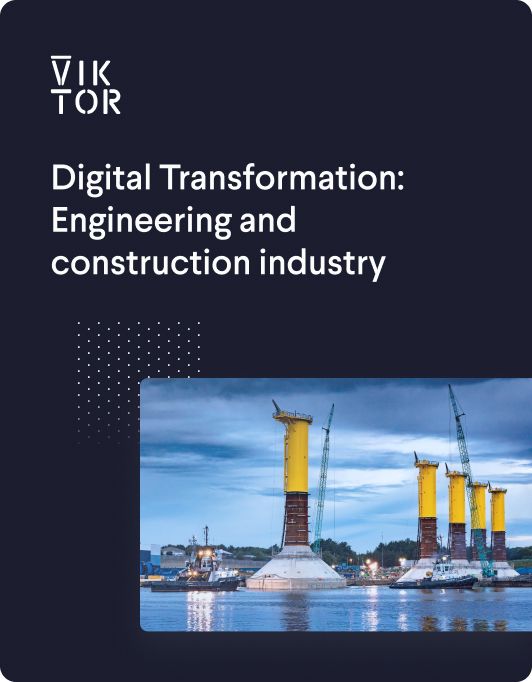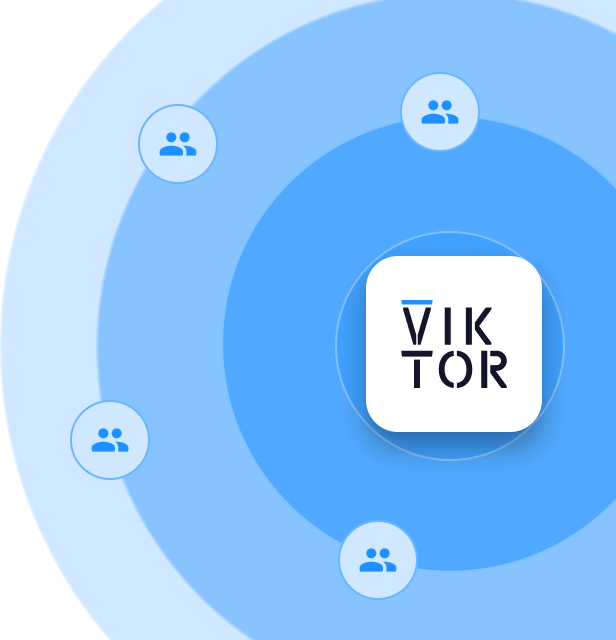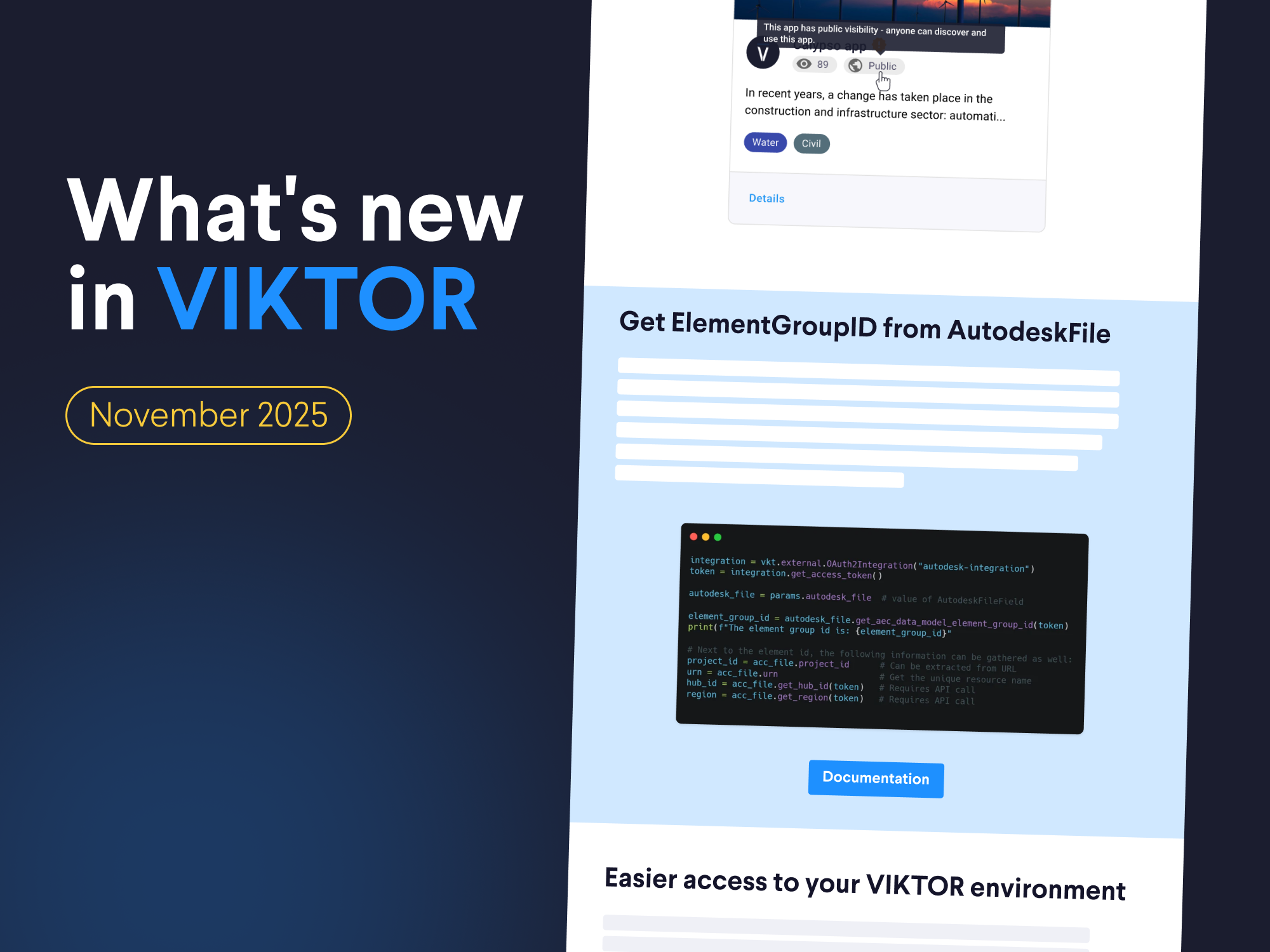February 27, 2024
Innovation in engineering through Citizen Development

by VIKTOR


Download the White Paper and get INSPIRED
Learn about trends in digital transformation and how they affect the engineering and construction industry.
Citizen development and digitization at Boskalis
by Bas Vos (Boskalis)
Bas Vos, Geotechnical Engineer and General Manager of Boskalis' in-house engineering department Hydronamic talks about the strategies Boskalis employs to foster citizen development to face challenges related to their projects. Some challenges concern the multidisciplinary nature of Boskalis projects (such as port construction, coastal development, and infrastructure building), which – combined with changing boundary conditions and environmental concerns – require adaptability from the company. So, how does Boskalis effectively harness these resources to support innovation?
A new generation of citizen development
At the heart of Boskalis' approach to citizen development in engineering design stands the engineer, developing software close to the engineering domain. Citizen developers can have a transformative impact on the company. By facilitating the transition from conventional tools like Excel to more dynamic Python-based solutions, our engineers can for example investigate multiple solutions within the same timeframe. Python versatility allows developers to explore existing solutions by importing relevant packages, accelerating the development process. In some cases, this process is enhanced by using LMM and AI tools like ChatGPT as developer assistants.
With more young professionals joining the industry with Python know-how from their university studies, Boskalis sees this valuable expertise as a crucial asset within the organization. By combining traditional engineering skills with modern programming knowledge, Boskalis is advocating for a new generation of professionals ready to influence the future of engineering.
Citizen development brings an important innovation: the transition towards developing project-specific software. While the creation of personalized software is already a practice, Boskalis envisions taking it a step further. The goal is to customize the software to meet the specific needs of each project, using a flexible framework of universal components combined with project-specific features.
How Boskalis supports citizen development
To promote citizen development at Boskalis, they prioritize community building and education for engineers. Consistency is crucial in community building, supported through regular events. These initiatives foster team engagement and connections both internally and externally. Boskalis also acknowledges the importance of upskilling engineers, offering educational programs to elevate their coding proficiency from beginner to intermediate levels, boost individual skills but also ensure effective governance over citizen development initiatives. You can learn more about Boskalis’ initiatives and education programs from min 06:40.
The synergy between citizen development and IT
The approach to promoting citizen development on a company level not only boosts individual skills but also ensures effective governance over citizen development initiatives, as people are encouraged to collaborate on centralized locations using software development best practices. This is important because, in the landscape of citizen development, all kinds of dilemmas can come to the forefront, often resulting in discussions between citizen developers and IT teams.
Freedom versus security
One of the primary dilemmas surrounds the tension between the freedom desired by developers and the imperative need for security within IT teams. Striking the right balance is crucial. There will always be a point where certain activities must transition from being under the autonomy of citizen developers to being tightly managed by IT. However, a gray area exists that requires ongoing communication between developers and IT to ensure that security concerns are addressed without affecting innovation.
One-off versus a service
When a citizen developer successfully creates a project, it may evolve from a one-time task to an ongoing service. However, this transition requires a shift in mindset. As the project expands, it's important to move from individual coding to adopting software development principles. This means considering lifecycle management, testing, support systems, and monitoring. Failing to plan for these changes early on can put digitalization efforts at risk and lead to dissatisfaction.
Innovation versus maintenance
The dilemma of innovation versus maintenance appears when a project evolves and requires ongoing support. Those who were initially enthusiastically developing something new, now find themselves changing into a support desk for their own product. Not always motivating and it limits their availability to work on new ideas. Defining ownership and who will handle maintenance is crucial for the project's scalability. Therefore, it's crucial to have IT involvement from the start of the project and citizen developers able to grasp the governance of the processes.
Go to minute 11:06 to see how Boskalis manages the process of creating a workflow for an application developed by citizen developers and later transferred to the IT department.
Check the full presentation of Bas at UCODE!
How BAM fosters citizen development
by Dirk van der Ploeg & Johan Tuls (BAM Group)
Dirk Van der Ploeg (Project Manager) and Johan Tuls (Lead Developer Python and Structural Engineer) explain how citizen development is an effective strategy within the digital engineering team at Royal BAM Group to empower engineers to automate tasks and exchange knowledge within the teams.
Digital engineering strategies at BAM
Royal BAM Group's current digital strategy prioritizes investing in its employees, ensuring that the teams in the company can stay current on the latest digital practices and integrate them into their everyday work.
This investment in digital engineering serves multiple goals, including reducing project risk, minimizing repetitive engineering tasks, and boosting employee satisfaction. By providing engineers with innovative tools, BAM looks to improve efficiency and effectiveness, positioning itself uniquely in the market over the long term.
In pursuit of this digital strategy, BAM adopts a project-centric approach. Projects serve as learning platforms where the company develops tools and applications with a focus on quick implementation and continuous improvement across multiple projects. Additionally, the company prioritizes keeping the size of its applications manageable to ensure ease of use for all users, thus lowering the barrier to entry into digital processes.
Also, BAM Group prefers to involve its engineers, including structural, geotechnical, and project management engineers, in the development process to ensure that the tools and applications are tailored to meet the specific needs of end users, helping smoother adoption and integration into daily workflows. For example, BAM Group has found that a mix of seasoned developers alongside those with less experience gives the best results within their digital engineering team. Moreover, they actively involve students in their teams to use the latest insights and knowledge emerging from the universities.
To further understand how these initiatives fit within the broader landscape of a large company, you can go to minute 05:40 of the presentation. Here, a visualization displays how these efforts align with the overarching goals of the organization and what role VIKTOR can play in supporting these efforts.
Citizen development with VIKTOR
Ensuring that the team has access to professional tools is important for BAM to effectively foster citizen development. Rather than reinventing the wheel, the company focuses on areas where they can add value and use the VIKTOR platform to achieve their digital engineering goals. Practical strategies, such as helping regular learning sessions, acknowledging, and celebrating successes, and maintaining patience during the learning process, are essential components of BAM's approach. Moreover, it is also a priority to support a close collaboration with their IT departments and integrate quality control and end-user testing into their development and Scrum processes.
For a closer look at the practical applications, go to minute 10:05 of the presentation. Here, two concrete examples of apps are highlighted.
Evolution of the architecture at BAM with digital engineering
At BAM, the shift from traditional structural engineering to digital methods happened gradually. Initially, engineers wrote scripts in PyCharm or Jupyter to automate repetitive tasks in civil and geotechnical work. However, as they coded more, they noticed they were repeating themselves. So, they bundled their efforts into reusable modules, forming a solid foundation for future digital projects. Realizing not everyone was a coding expert, BAM tried different interfaces like Django and Flask. But these led to lengthy front-end development, distracting them from their focus on civil engineering. At this point, they opted for VIKTOR to replace the custom front-end work, which allowed them to focus on the core business needs. Their digital projects now follow a standard structure: easy-to-use interfaces for input, robust models for logic and data, analysis with external tools or Python, and clear visualization of results. To make their projects even better, BAM separated backend components carefully to improve performance and avoid repeating work.
At minute 16:53 of the presentation, you can learn about BAM's open library initiatives, called Blueprints. This innovative program aims to share existing knowledge within civil and geotechnical companies, ensuring that teams do not duplicate efforts and instead build upon existing resources.
Watch their full UCODE presentation here!
From citizen development to high-value technical delivery
by Marina Villanueva Diaz (Jacobs)
Marina Villanueva Diaz, Global Technology Lead for design automation at Jacobs, explains how Jacobs plans to change the future of the AEC industry using citizen development and digital innovation.
Common AEC challenges
In the AEC industry, most companies face the same key challenges.
-
Clients increasingly demand sustainable solutions, incorporating criteria like energy performance, embedded carbon calculations, and life cycle costs into project deliverables. Meeting these design requirements poses a significant hurdle for industry professionals.
-
Another pressing issue is the industry's sluggish digital adoption. Despite the offer of available technologies, AEC workflows are still sometimes disjointed and inefficient. The sector lags in making use of the full potential of digital tools, hindering productivity and innovation.
-
Moreover, many experienced workers are retiring, and there is a risk of losing valuable knowledge unless firms proactively implement strategies to retain and transfer expertise within their organizations.
How to solve AEC challenges
To tackle these challenges, companies can adopt several strategies.
-
Working smarter by investing in process improvement. This means addressing both simple issues and completely redesigning processes to make them more efficient.
-
Prioritizing automation and software development, including initiatives in data science, to streamline their operations and increase productivity.
-
Focusing on knowledge management. This involves implementing upskilling programs and investing in continuous learning to keep employees abreast of the latest industry trends and technologies.
-
Accelerating knowledge transfer within the organization is also crucial to ensure that the wealth of expertise held by senior professionals is effectively passed down to younger generations.
Two models to drive change in organizations
Citizen-Led Development
This model, also known as the distributed model, relies on organic growth and dissemination of change. It involves initiatives led by individuals within the organization rather than a centralized authority. While this approach fosters innovation and community movements, it comes with certain risks. Citizen-led initiatives are typically ungoverned and may progress slowly, depending on the followers' ability to mobilize and support each other. The initiatives may also lack proper governance and value unless risks are carefully managed and understood.
Centralized Approach
The centralized approach involves mobilizing a dedicated team to strategically plan and drive change in a controlled manner. This model requires executive endorsement, governance processes, and financial accountability. While it allows for clear communication and resource allocation, it has limitations. For instance, in a design automation program, the focus is often on a "push system," where investments are based on forecasted demand. However, this approach carries risks of overestimating adoption and accumulating excess resources. Additionally, scalability may be limited due to the central team's fixed capacity.
Visit minute 07:52 to see the start of a citizen-led movement and min 14:56 to see an introduction to design automation process at Jacobs
Centralized citizen-led development
Jacobs's recipe for success is a hybrid approach, incorporating the strengths of both models. This new model is built on three pillars.
Citizen Development and community building
Jacobs has focused on fostering citizen development and growing a community of practice, expanding from 100 to 800 members in just three years. They implemented VIKTOR to support this initiative, promoted source control across the organization, and collaborated with IT for quality assurance.
Creating new solutions and upskilling
Jacobs has developed training programs and made them available through their learning management system to enhance employee skills. They've also established an incubation process to identify and prioritize ideas, with a central team managing product development, marketing, and change management. Attention is placed on the lifespan and maintainability of solutions.
On-Demand Automation
To address the limitations of the push system, Jacobs is implementing a third pillar focused on on-demand automation. The goal is to deliver solutions quickly and effectively across the business and projects, prioritizing efficiency, cost savings, and quality improvements over long-term maintainability. This approach aims to expand the impact of automation throughout the organization.
A success story
During this journey, Jacobs has created around 10 tools that are now used globally as part of the program. For further insights into the lessons learned by Jacobs throughout this journey, you can go back to the video at minute 22:46.
Generative design at VINCI Construction
by Alexandre Cousin (VINCI)
Alexandre Cousin, Head of Generative Design and Founder of Synaps'Up at VINCI Construction France, discusses generative design at VINCI and shows its potential to optimize processes and transform the company's operations.
To introduce the topic Alexandre explains the difference between parametric- and generative design. Whereas parametric design is about making the characteristics of a model or object adjustable for simple modification, generative design is a parametric model that is enhanced with intelligence through algorithms. Rather than manually adjusting the model for various configurations, generative design employs algorithms to focus on specific goals or constraints, automating the optimization process, and allowing for more productivity, creativity, and savings.
Why generative design?
At VINCI, generative design is a valuable tool for civil engineers in their everyday tasks. Whether it's designing buildings, bridges, or tunnels, engineers face tight deadlines and shifting data inputs. This often requires them to generate multiple design proposals as data changes and deadlines approach. Moreover, while engineers may come up with good ideas on their own, generative design allows them to explore a wider range of options and find the most effective one. This reduces the risk of human error, enhances result reliability, and ultimately leads to a high and secure return on investment.
To gain deeper insights into the practical application of generative design in civil engineering projects at VINCI, you can watch from the 06:57 minute.
Generative design: how does it work?
Generative design works according to three steps: generate, evaluate, and evolve.
-
Generate: Initially, the software generates a range of solutions based on defined concepts, constraints, and goals set by the designer. For instance, constraints may include environmental zones, while goals could revolve around minimizing environmental impact.
-
Evaluate: The software then evaluates these solutions, converging towards the best ones rather than exploring randomly and saving a lot of manual effort for the engineers. Evaluation methods can be classified as single-objective or multi-objective. The first involves focusing on a single goal, such as minimizing cost. In contrast, multi-objective evaluation focuses on multiple parameters simultaneously, leading to a range of solutions represented graphically as a Pareto front. Each point on the Pareto front means a different solution, with some offering trade-offs between goals, i.e. cost and environmental impact.
-
Evolve: Finally, algorithms are used to generate and refine solutions. Initially, a range of random solutions is generated, and through iterations, these solutions are improved in quality. For example, various random designs are tested in designing a road, yielding a mix of poor, average, and potentially good designs. Promising solutions are identified and used to inspire new designs, mimicking natural selection's process of refining advantageous traits over generations.
Generative design doesn't replace engineers but transforms the way they work, using computers as tools to help in finding the best solutions and saving a lot of time. What are the applications of generative design in different industries? It's widely used in manufacturing, aerospace, automotive, technical wear design, and in the AEC.
Check out Alexandre's presentation from minute 18:09 to see some interesting examples.

Let us show you how VIKTOR
can help you solve any challenge
Related Blog Posts
Get our best content in your inbox
Subscribe to our newsletter and get the latest industry insights


